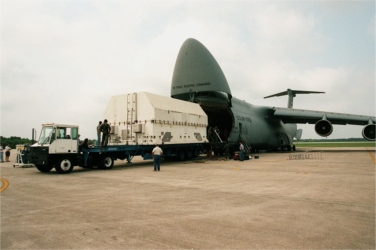|
|
|
The C-5 is one of the largest aircraft in the world. It can carry outsized cargo intercontinental ranges and can take off or land in relatively short distances. Ground crews can load and off load the C-5 simultaneously at the front and rear cargo openings since the nose and aft doors open the full width and height of the cargo compartment. It can also "kneel down" to facilitate loading directly from truck bed levels. Other features of the C-5 are:
The C-5 is similar in appearance to the smaller transport aircraft, the C-141 Starlifter, although the C-5 is much larger. Both aircraft have the distinctive high T-tail, 25-degree wing sweep and four turbofan engines mounted on pylons beneath the wings. The Galaxy carries nearly all of the Army's combat equipment, including such heavy oversized items such as its 74-ton mobile scissors bridge, from the United States to any theater of combat on the globe.
Four TF-39 turbofan engines power the big C-5. They are pylon-mounted and rated at 41,000 pounds thrust each. They weigh 7,900 pounds (3,555 kilograms ) each and have an air intake diameter of more than 8.5 feet (2.6 meters). Each engine pod is nearly 27 feet long (8.2 meters).
The Galaxy has 12 internal wing tanks with a total capacity of 51,150 gallons (194,370 liters) of fuel -- enough to fill more than six regular size railroad tank cars. The fuel load weighs 332,500 pounds (150,820 kilograms) allowing the C-5 with a load of 204,904 pounds (92,207 kilograms) to fly 2,150 nautical miles, offload, and fly to a second base 500 nautical miles away from the original destination -- all without aerial refueling. With aerial refueling, crew endurance is the only limit to the aircraft's range.
BackgroundLockheed-Georgia Co. delivered the first operational Galaxy to the 437th Airlift Wing, Charleston Air Force Base, S.C. in June l970. C-5s are stationed now at Altus AFB, Okla.; Dover AFB, Del.; Travis AFB, Calif. and Kelly AFB, Texas. AMC transferred some C-5s to the Air Reserve starting with Kelly AFB, in 1985; followed by Stewart Air National Guard Base, N.Y. and Westover Air Reserve Base, Mass.
In March 1989, the last of 50 C-5B aircraft were added to the 76 C-5A's in the Air Force's airlift force structure. The C-5B includes all C-5A improvements as well as more than 100 additional system modifications to improve reliability and maintainability. All 50 C-5B's are scheduled to remain in the active-duty force, shared by comparably sized and collocated Air Force Reserve associate units.
The C-5, C-17 Globemaster III and C-141 Starlifter are partners of AMC's strategic airlift concept. The aircraft carry fully equipped, combat-ready military units to any point in the world on short notice then provide field support required to help sustain the fighting force.

